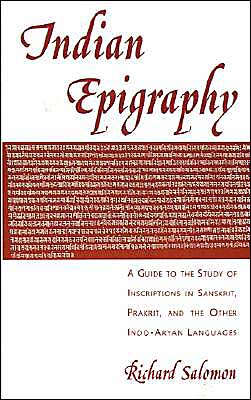Indian Epigraphy: A Guide to the Study of Inscriptions in Sanskrit, Prakrit, and the Other Indo-Aryan Languages
This book provides a general survey of all the inscriptional material in the Sanskrit, Prakrit, and modern Indo-Aryan languages, including donative, dedicatory, panegyric, ritual, and literary texts carved on stone, metal, and other materials. This material comprises many thousands of documents dating from a range of more than two millennia, found in India and the neighboring nations of South Asia, as well as in many parts of Southeast, central, and East Asia. The inscriptions are written,...
Search in google:
This book provides a general survey of all the inscriptional material in the Sanskrit, Prakrit, and modern Indo-Aryan languages, including donative, dedicatory, panegyric, ritual, and literary texts carved on stone, metal, and other materials. This material comprises many thousands of documents dating from a range of more than two millennia, found in India and the neighboring nations of South Asia, as well as in many parts of Southeast, central, and East Asia. The inscriptions are written, for the most part, in the Brahmi and Kharosthi scripts and their many varieties and derivatives.Inscriptional materials are of particular importance for the study of the Indian world, constituting the most detailed and accurate historical and chronological data for nearly all aspects of traditional Indian culture in ancient and medieval times. Richard Salomon surveys the entire corpus of Indo-Aryan inscriptions in terms of their contents, languages, scripts, and historical and cultural significance. He presents this material in such a way as to make it useful not only to Indologists but also non-specialists, including persons working in other aspects of Indian or South Asian studies, as well as scholars of epigraphy and ancient history and culture in other regions of the world.
AbbreviationsxviiNote on Citation and Bibliographic Formxxi1The Scope and Significance of Epigraphy in Indological Studies32Writing and Scripts in India72.1General Introduction72.1.1Writing in traditional India72.1.2The antiquity of writing in India of the historical period102.1.3Characteristics of Indic writing142.2The Brahmi Script and Its Derivatives172.2.1Geographical and chronological range172.2.2The name of the script172.2.3The origin of Brahmi192.2.4Characteristics of Brahmi in the Mauryan period (third century B.C.)302.2.5The historical development and derivatives of Brahmi312.3The Kharosthi Script422.3.1Geographical range422.3.2Chronological range462.3.3Uses of Kharosthi472.3.4Paleographic features of Kharosthi482.3.5The name of the script502.3.6The origin of Kharosthi512.3.7Connections between Kharosthi and Brahmi542.3.8The paleographic development of Kharosthi552.4Numbers and Numerical Notation562.4.1Numerical notation in Brahmi and the derived scripts562.4.2Numerical notation in Kharosthi632.5Techniques of Epigraphic Writing642.5.1General comments642.5.2The technical execution of inscriptions652.5.3Calligraphic writing682.5.4Biscript inscriptions702.6Undeciphered Scripts713The Languages of Indic Inscriptions723.1Middle Indo-Aryan ("Prakrit")723.1.1General remarks723.1.2The Prakrits of the Asokan inscriptions733.1.3Other inscriptions of the Mauryan era763.1.4Later inscriptional Prakrits763.1.5Literary Middle Indo-Aryan in inscriptions803.2Mixed or "Hybrid" Dialects813.2.1The character of "Epigraphical Hybrid Sanskrit" (EHS)813.2.2Geographical and chronological distribution of EHS823.2.3The linguistic nature of EHS833.3Sanskrit863.3.1The earliest Sanskrit inscriptions863.3.2Early Sanskrit inscriptions from Mathura873.3.3Sanskrit inscriptions from western India in the Ksatrapa period883.3.4Early Sanskrit inscriptions from the Deccan and southern India903.3.5Early Sanskrit inscriptions from other regions923.3.6The emergence of Sanskrit in the Gupta period923.3.7Summary: Historical and cultural factors in the development of Sanskrit as an epigraphic language933.3.8Linguistic characteristics of inscriptional Sanskrit943.4The New Indo-Aryan (NIA) Languages993.4.1Marathi1003.4.2Oriya1013.4.3Gujarati1013.4.4Hindi and related languages and dialects1023.4.5Bengali and other eastern NIA languages1043.4.6Nepali1043.4.7Sinhalese1043.5Other (Non-Indo-Aryan) Languages in Indian Inscriptions1053.5.1Dravidian languages1053.5.2Islamic languages (Arabic, Persian, Urdu)1063.5.3Other non-Indic languages1073.6Bilingual and Multilingual Inscriptions1094Survey of Inscriptions in the Indo-Aryan Languages1104.1Typological Survey1104.1.1Royal donative and panegyric inscriptions (prasasti)1104.1.2Land grant (copper plate) characters1134.1.3Private donations1184.1.4Memorial inscriptions1194.1.5Label inscriptions1204.1.6Pilgrims' and travelers' records1214.1.7Cultic inscriptions1224.1.8Literary inscriptions1234.1.9Seal inscriptions1234.1.10Miscellaneous inscriptions1244.2Survey by Form and Material1264.2.1Stone1264.2.2Metals1294.2.3Earthen materials1304.2.4Wood1314.2.5Miscellaneous materials1314.3General Survey of Inscriptions1324.3.1Inscriptions of the Mauryan period (third century B.C.)1334.3.2Inscriptions of the Sunga period (ca. second to first centuries B.C.)1414.3.3Inscriptions of the Indo-Greek and Indo-Scythian era (ca. second century B.C. to third century A.D.)1424.3.4Inscriptions of the Gupta era (fourth to mid-sixth centuries A.D.)1454.3.5Inscriptions of the post-Gupta or "Medieval" era (mid-seventh to tenth centuries A.D.)1464.3.6Inscriptions of the "Islamic period" (eleventh to eighteenth centuries A.D.)1484.3.7Extra-Indian inscriptions1505Methods of Epigraphic Study1615.1The Presentation of Inscriptional Texts1615.1.1Reproduction of the original inscription1615.1.2Presentation of the edited text1625.2Translation and Interpretation of Inscriptions1645.3Authentication of Inscriptions1655.4Dating of Inscriptions1685.4.1Undated or inadequately dated inscriptions; paleographic dating and problems thereof1685.4.2Dated inscriptions1705.4.3Conversion and verification of inscriptional dates1765.5Appendix: Eras Used in Indo-Aryan Inscriptions1805.5.1Continuous (historical or pseudohistorical) eras1805.5.2Cyclical (astronomical) eras1966The History of Indian Epigraphic Studies1996.1The Pioneering Era: Early Readings of Indian Inscriptions (1781-1834)1996.2The Era of Decipherment (1835-1860)2036.2.1Decipherment of the early Brahmi script2046.2.2Decipherment of the Kharosthi script2096.2.3Other developments during the era of decipherment2156.3The Period of Maturity (1861-1900)2176.4The Modern Period (1901-1947)2216.5Indian Epigraphy Since Independence (1947 to the present)2236.6Future Prospects and Desiderata2247Epigraphy as a Source for the Study of Indian Culture2267.1Epigraphy and History2267.1.1Political and dynastic history2267.1.2Administrative, economic, and social history2317.2Epigraphy and the Study of Indian Literature2327.2.1Inscriptions as a source for the history of Indian literature2337.2.2Inscriptional texts as literature2357.3Epigraphy and the Study of Religion2387.3.1The Brahmanical/Hindu tradition2397.3.2Buddhism2417.3.3Jainism and other sects2437.4Epigraphy and the Study of the Arts2447.4.1The visual arts2447.4.2The performing arts2487.5Epigraphy and Linguistics2487.6Epigraphy and Geography2497.7Other Fields2508Bibliographic Survey2528.1Primary Sources: Notices and Editions of Inscriptions2528.1.1Periodicals2528.1.2Epigraphic serial publications2548.1.3Anthologies of inscriptions2558.1.4Separate monographs2578.2Secondary Sources: Handbooks and Reference Works2578.2.1Handbooks of epigraphy and paleography2578.2.2Reference works, bibliographies, and lists2598.2.3Miscellaneous studies and collections260AppendixSelection of Typical Inscriptions2621.Rummindei minor pillar edict of Asoka2622.Besnagar pillar inscription of Heliodoros2653.Bharhut label inscriptions2674.Kalawan copper plate inscription2675.Sarnath umbrella shaft inscription of the time of Kaniska2706.Niya (central Asian) Kharosthi document2727.Kahaum pillar inscription of the time of Skandagupta2738.Lakkha Mandal prasasti2759.Vat Ph'u stone inscription of Jayavarman [I]28010.Baroda copper plate inscription of Rastrakuta Karkkaraja [II]28311.Tiruvenkadu temple inscription29512.Nalanda inscription of Vipulasrimitra29713.Pilgrim inscription on the Kosam pillar30214.Burhanpur inscription of Edala-Saha (Adil Shah)30415.Pabhosa Jaina inscription307Bibliography311Index of Inscriptions Cited328Index351
